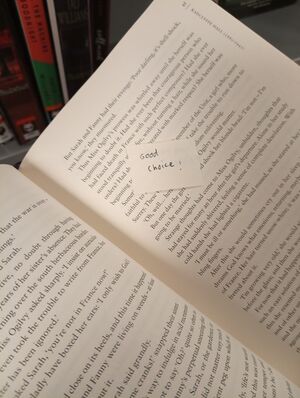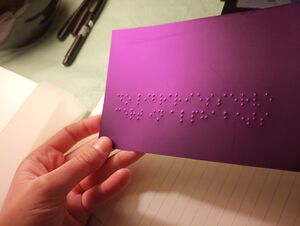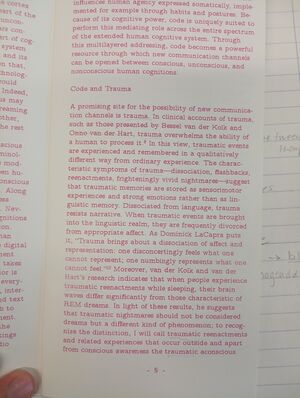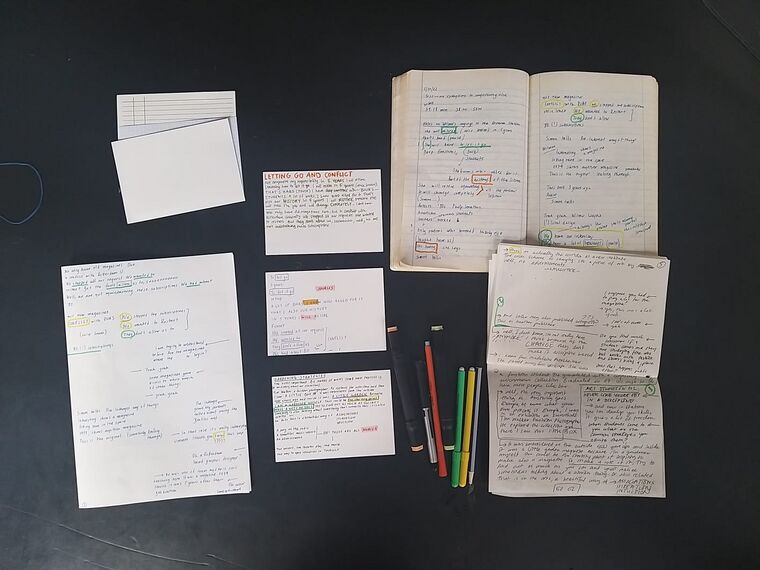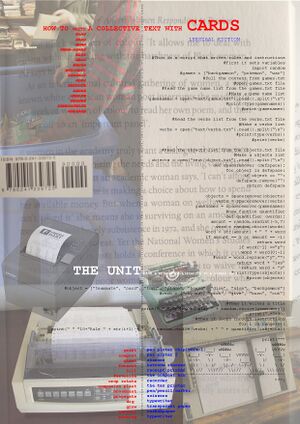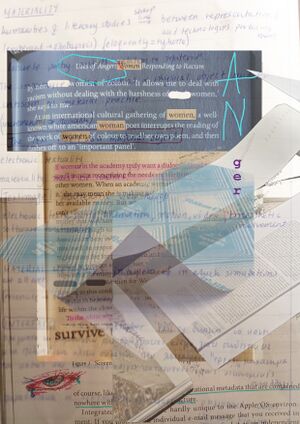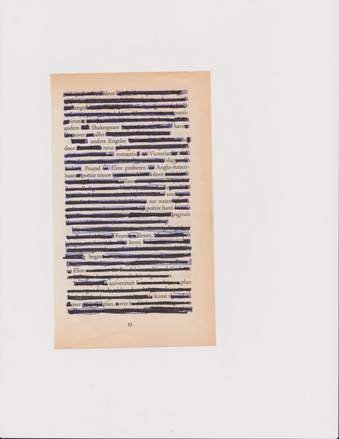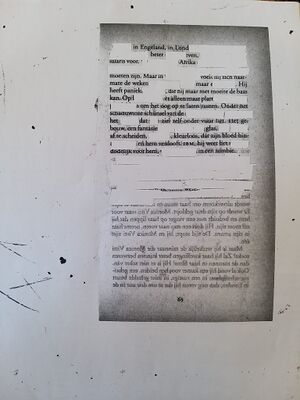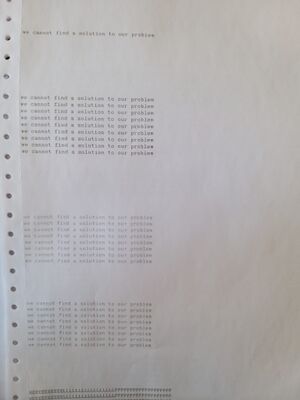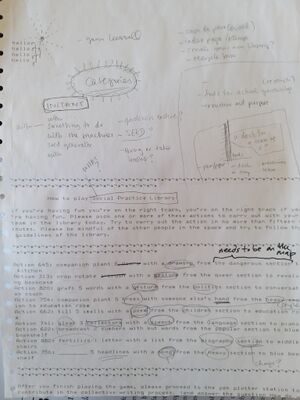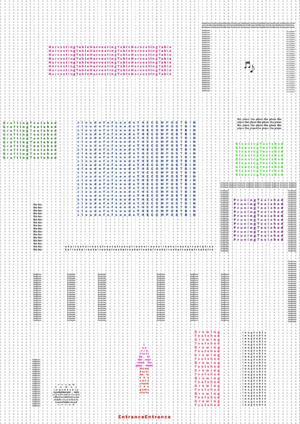How do We Library That???
How Do We Library That?ή πως το ουσιαστικό μετατρέπεται σε ρήμα/σε ενέργεια?
Library Tour
Making Cards the first cards
talking notes | notes talking
Boyana, Suzan and Aglaia started their tour by visiting the Central Library of Rotterdam on Friday. They went to the third floor to search for some inernational books. Wandering around at the english section Suzan picked the book Queer: LGBTQ writing from Ancient Times to yesterday edited by Grank Wynne. She started leafing through when suddenly came across a notes' discussion-a small square piece of paper:
- -Good choice!
- -I very much agree!
sensorship / lybraille-e
or lyi(brar)ing down in the margin (degrees of representation- there is a diagram at the paper of Olson "Mapping beyond Dewey's Boundaries")
see also: digitizing/printing, being kind to the reader, republishing
see also: censorship, including/excluding
All reading is a form of touching, and the act creates a connection between the reader and the text. Some texts encourage reading from certain readers (such as those typeset in braille), while some attempt to be universally accessible (such as those using OCR-A and OCR-B fonts).
Apparently the title "The Medium is the Massage" was in fact a typo after being sent to the typesetter, but McLuhan liked it so much that it was kept. Massage and also Mass Age alongside the original Message and Mess Age suggest multiple ways of approaching the text.
Reimaging together the library as a structure/institution/entity- the Hero and the CarrierBag Library
Hero Library
What is the economy of knowledge? How knowledge was produced and distributed in the hero library?
you have to pay something in order to get access, earn it. you have to be able to afford it.
it's exclusive not inclusive
cannon - 1/ power - 2/ wealth - 3/ growth
hero's library would be monumental with columns.
silent
how do you make a library start and end
limited access (physical or non-physical, stairs or paywall)What is the economy of knowledge? How is knowledge distributed and produced?
the same translates to non-phisical spaces but digital libraries too. subscription models and levels of access
special cards and special treatments and monumental large scale concrete/marble/stone buildings.. the few privileged ones get the most special knowledge the most valuable.. what is the most valuable knowledge? who are the privileged ones? how did they manage to acheive this? the top? UP/VERTICAL, surveillance and control, aesthetics of power (regarding the construction)---maybe the knowledge itself has to do with the consumption/we consume knowledge/information we do not create/produce
no non-silent rooms or group working areas
obedience
the knowledge is rather taken (acquired) from somewhere else, many levels from bottom to the top. the higher you go the most important stuff you can access (the most valuable knowledge)
big history section on victories
censorship?
security
many mirrors inside
property/ ownership of knowledgement
Hero's library slogan:
hoc est quod vos adepto
echo chamber (Stephen)
-there may be many replicas of the same book. "the bible of the hero library" rewritten, how to read "the bible of the hero library", new edition, new cover etc.
there can only be one hero library (with notion to capitalism as Bo said)
Carrier Bag Library
What is the economy of knowledge? How knowledge was produced and distributed in the Carrier Bag library?
free access, exchangeable, everyone has the same
you could request books depending on your research
what monuments could there be?maybe no static monuments.. maybe counter monuments-always vulnerable and transformative
flexible, open, adjustable, circular, limitless (can add and add and add and transform), without borders, liquid or smooth textured, horizontal, people make their own decisions/terms of classification/organization
A bag where people add as much as take away, where the mastery of knowledge is less important than the sharing of information, mutual knowledge
Leeszaal (no checkout, relationship built on trust and knowledge not seen as private propriety) Within a society of surplus, book donation makes sense
looks like a net (network), each part is connected to each other, through knots _ nodes (some small, some bigger)
infinite?
no checkout policy
mobile and it can change place
Who has ownership over the objects?
open to risks- but easy to reconstruct due to collectivity (knowledge is fluid)
living form/changing constantly- knowledge to find solutions
bags made of reeds
what happens if a carrier bag librarian walks into a hero library? what would give them away?
^^^this sounds like the start of a joke
what are the rules in a carrier bag library? who decides the rules, are they fixed?
An archive that is not static, is only useful if it's useful to usersThere can be more than one carrier library in contrast to capitalism."May be seen as necessary elements of a whole, which itself cannot be characterised either as conflict or as harmony since its purpose is neither resolution nor stasis but continuing process" - LeGuin on carrier bags
Carrier bag library slogan(s):
Donna Harraway (riffing on Ursula LeGuin's HBToF):“It matters what matters we use to think other matters with; it matters what stories we tell to tell other stories with; it matters what knots knot knots, what thoughts think thoughts, what descriptions describe descriptions, what ties tie ties. It matters what stories make worlds, what worlds make stories.”
To edit the vosk-trascribed text
(the process of trauma)
I replace the original word trauma in the text with the word blue. Why blue? There is no special or deeper reason for me choosing to replace the trauma with blue. Maybe I was feeling a little blue on Monday so it has something of me also. Additionally, the written brochure text was in magenda colour and I thought blue was a nice contrast. I considered it as a nice play. This is how voxt translated my voice and my balkan/greek pronounciation into written digital text . Irestored the machine's mistakes. I replace the word trauma with blue and I gave some space after the traymatic blue
Here the vosk trenscribed text:
gold and blue a promising side of the bushmeat of new communication channels as blue niggling clinical accounts of blue such as those person by bessie of on the call and on of on the heart blue overwhelms the ability for human process it in this few blue events are experiencing remembered inequality bleed the a friend away from ordinary experience a characteristic symbols of blue is this association flashbacks reenactments frighteningly with nightmares suggests that blue members are stored does sensory motor experience and struggle motions or other than assume waste memory dissociate from language blue resist narrative when blue events are brought into the linguistic reality they are frequently the from appropriate effect as dominic look out but boots blue brings about association of effect and representation one disconcertingly fees that one cannot represent one numbingly represents what one cannot fee moreover been cold and of on their huts research indicates that the when people experience blue reenactments while sleeping their brain waves the for a significantly from those characteristic of rdm dreams in light of this result he suggests that blue nightmarish not be considered dreams but a different kind of phenomenon who recognized distinction a will call blue reenactments related experience that a cure outside and apart from conscious awareness the blue unconscious
The edited text:
a promising site of the possibility of new communication channels is blue
in clinical accounts of
blue
such as those presented by Bessel van der Kolk and Onno van der Hart
blue
overwhelms the ability for a human to process it in this view
blue
events are experienced and remembered in an qualitatively different way from ordinary experience the characteristic symptoms of
blue
is dissosiation flashbacks reenactments frighteningly vivid nightmares suggests that
blue
memories are stored as sensorimotor experiences and strong emotions rather than as linguistic memory dissociated from language
blue
resists narrative when
blue
events are brought into the linguistic realm they are frequently divorced from appropriate affect as Dominick LaCapra puts it
blue
brings about dissociation of affect and representation one disconcertingly feels what one cannot represent one numbingly represents what one cannot feel moreover van der Kolk and van der Hart's research indicates that when people experience
blue
reenactments while sleeping their brain waves differ significantly from those characteristic of REM dreams in light of these results he suggests that
blue
nightmares should not be considered dreams but a different kind of phenomenon to recognize the distinction I will call
blue
reenactments and related experiences that occur outside and apart from conscious awareness the blue
aconscious
https://criticalinquiry.uchicago.edu/traumas_of_code_by_n._katherine_hayles
Transcribing Wilma's sayings with Irmak- THE CARDS
Project description (log line)
what: 2 handwritten transcriptions of the same text. An extract of an interview with Wilma, librarian at WdK and HR for the last 36 years. The two handwritten transcriptions serve as a conversation between the two notetakers. The similarities and differences between the two texts. (At time of talking these notes). Ingedients include: pen, pencil, paper, ears, hands. The conversation can be extended to more cards.
how:-(At time of talking these notes [2pm]) The [5] cards serve as an interface to other texts (through hyperlinks and references)
why: Both Aglaia and Suzan were interested in conveying the space and atmosphere of the conversation. They want to convey the experience of the conversation (and not just the information it transmits).
Steps needed:
- make 5 cards
- separate into scenes (there was an order to the notes, but the cards could have an order or not!)
- more structure: makes it more legible
- less structure: good because its a game (it flows).
- maybe potential for people to add their own cards? the not-solid structure might give this possibility, even if complicated.
- How can they make the people using the card understand the atmospher/have the same experience
- Aglaia says other people cant ultimately have the same experience though (goal unachievable), or is it?
- play with sound effects and typography, maybe work the sound effects into the text like a play
- how can a reader of the card understand phrases like ("this book")
- Make a shelf on the b side of the cards maybe, when you read "this" and it's underlined or footnoted, you can turn the card around and it's referencing the footnote
- maybe a qr code?
- reference to position in the library
- aglaia took more vertical approach to the text, while suzan took more linear and tried to follow the conversation between te people speaking
- aglaia made more of a note mapping
I saw a little box which was found in the collection of the Victoria and Albert Museum. The box was embroidered on the outside over four hundred years ago. And when it was opened, inside was a tiny ornamental garden. - Willem de Koonig Academie Librarian, Wilma
Unpacking what is workshop, game, manifesto, note-taking with Steve
https://pad.xpub.nl/p/SI19-20221109
(on preparation for the Leeszaal event)
A game would be a dynamic transformative system of rules for an excavation appliable to library-organisms emerging through public. Libraries (or book collection) conceived as plain texts to be shaped via our collective writing tools. In which terms would do we invite others to library that together? What is the starting point? Do we collectively write/create/construct the tools or we just provide them with some ? Sitting in the carpet sea. (this is space-specific)The carpet as a symbol to bring people together in a circular way and write together We are inviting every librarian (librarians of their own library) to take part in discovering how they approach library systems and the space itself collectively. We will try to create a collective writing piece, an instant print at the release time s an exploration of networks of humans and texts, their context and modes of operation. A way to make the community’s vision of a library known and written. A community-first system to remember, to archive a collection. Our publication is a momentary snapshot of the current state of Leeszaal library seen as a garden of knowledge and people who experience it in that very moment.
What is a game? A game can re-create space and time. Roles are distributed. Can be a utopia or an heterotopia . It is a system that construct new relationships, rules, laws, worlds, sceneries, universe(s). It can be a material or immaterial “thing” - float in our imagination. Human and non human animals play. It doesn’t really need consciousness. I conceive the act of playing as an always collective act. Dixit Monopoly (I love this capitalist game!) The apples Our try to construct a tree house Wizard face animal object Most of these games are deeply connected with my childhood or maybe a reconstruction of it at this specific moment. There is a sense of nostalgia. They are part of my memory box. I have a tendency to conceive things through a filter of past. childhood or maybe a reconstruction of it at this specific moment. There is a sense of nostalgia. They are part of my memory box. I have a tendency to conceive things through a filter of past.
what is a workshop An pre-scheduled event usually well-or efficiently organised with (or not) defined purpose. It is a collective process of learning, teaching, sharing, producing or creating things. It can be space oriented (you choose the place where is going to take place for a reason). I cannot really understand the word etymologically work-shop. Is it related with a give-and-take process? Maybe yes.
what is a manifesto A manifesto can be an attempt for a definition or maybe declaration of an intention a purpose or . It is generated collectively and somehow it can be related with identity (-ies). It can be also a proof of concept. Manifestos sometimes tend to be concrete and solid. In this case it can be something liquid.
MATERIALISING THE METAPHOR ? HOW IMPORTANT IS TO GARDEN THE LIBRARY?
"Traditionally metaphor has been defined as a verbal figure. Derived from a root meaning bearing across, it denotes the transfer of sense associated with one word to another. In Egan’s fictional scenario, the transfer takes place not between one word and another but rather between a symbol (more properly, a network of symbols) and material apparatus. This kind of traffic, as old as the human species, is becoming increasingly important as the symbol-processing machines we call computers are hooked into networks in which they are seamlessly integrated with apparatus that can actually do things in the world, from the sensors and actuators of mobile robots to the semiotic-material machinery that changes the numbers in bank accounts. To account for this traffic I propose material metaphor, a term that foregrounds the traffic between words and physical artifacts."
Preparing a prototyping for the release
the convergence betwen the Garden and the Library as systems of classification
(to wright analytically all the terms. Which terms do we keep? Why the metaphor is so essential to us? Personally speaking, the GARDENING metaphor is not always that fruitful to me regarding the librarying. Sometimes is super confusing. However, I had to argument on the gardening of metaphor in relation to the libraries, I would say that both - the garden and the library- are human-made organisational/classifiatory systems which include the act of distracting objects etc and replacing into an other context/framework under/via specific rules/actions. I would be really interested in investigating one day the way libraries were used as colononization instruments- in the specific case of Netherlands 's colonies (since I happened to be here). Interested reading:
https://www.jstor.org/stable/25549496 In this article is mentioned thatThe word is a virus - Burroughs , https://www.youtube.com/watch?v=KvOoR8m0oms&ab_channel=stereomusicvideo"The Ethische Politiek (Ethical Policy), enacted in 1900, mandated a variety of programs intended to benefit Indies colonial subjects and the new capitalist direction of the colonial economy. Among them was an expansion of native education, designed to prepare Indies natives to enter the workforce.
Taman Pustaka in Indonesian language means Garden of Reading and means Library.
entertaining material in order to retain the habit of reading. Since Balai Pustaka books, journals, and almanacs would constitute a monopoly on published material in the villages, why not make sure these reading materials taught the "right" values?
By the early 1920s Balai Pustaka was publishing original novels in lo cal languages, translations of European juvenile adventure books, and versions of local stories and epics. Its original novels were closely moni tored for religious and political comment, and descriptions of immoral behavior were forbidden as well. The situation in a stereotypical Balai Pustaka novel is a (young, modernized) character's conflict with some aspect of adat (customary law). Values such as cleanliness and depend ability and consumer goods like watches and radios are conspicuous.These novels consciously undermined tradition and guided their readers toward their positions as salaried consumers in the new colonial regime. Similarly, translated European novels originally intended for adolescents were notable for their "safeness." Versions of tales from the great Indian epics were reshaped with Western notions of narrative flow and personal propriety. Balai Pustaka also spread its message of Westernization through a number of periodical publications. "
“The word is now a virus. The flu virus may have once been a healthy lung cell. It is now a parasitic organism that invades and damages the central nervous system. Modern man has lost the option of silence. Try halting sub-vocal speech. Try to achieve even ten seconds of inner silence. You will encounter a resisting organism that forces you to talk. That organism is the word.”
From work to text"denotes transfer of sense associated with one word to another. The transfer between a symbol (network of symbols) and a material apparatus. Symbol-processing machines we call computers. Material metaphor --> a term that foregrounds a traffic between words and physical artifacts. " "Book as material metaphor but in fact it is an artifact whose physical properties and historical usage structure our interactions with in ways obvious and subtle."
The Text is not to be thought of as an object that can
be computed. It would be futile to try to separate out
materially works from texts. I The difference is this: the work is a
fragment of substance, occupying a part of the space of books
the text is a process of demonstration, speaks according
to certain rules (or against certain rules);
(in a library for example), the Text is a methodological
field. the one is displayed (εκτείθεται), the other demonstrated
only exists in the movement of a discourse (or rather, it is
Text for the very reason that it knows itself as text); the
Text is not the decomposition of the work, it is the work that
is the imaginary tail of the Text; or again, the Text is
experienced only in an activity of production. It follows that
the Text cannot stop (for example on a library shelf);
its constitutive movement is that of cutting across (in
particular, it can cut across the work, several works).
2. In the same way, the Text does not stop at (good)
Literature; it cannot be contained in a hierarchy, even in a
simple division of genres. What constitutes the Text is, on
the contrary (or precisely), its subversive force in respect of
the old classifications. How do you classify a writer like
Georges Bataille? Novelist, poet, essayist, economist,
philosopher, mystic? The answer is so difficult that the
literary manuals generally prefer to forget about Bataille
who, in fact, wrote texts, perhaps continuously one single
text. If the Text poses problems of classification (which is
furthermore one of its 'social' functions), this is because it
expression from Philippe Sollers).
the UNIT: always involves a certain experience of Unfits (to take up an from a library network (of real and unreal libraries) ---> to Leeszaal ---> to the section ---> to the bookcase(the furniture) ---> to the bookshelf ---> to the book (a work?) ---> to the page ---> to the text ---> to the word <------- to the collective text - the demostrated one page as a unit of reading, binding pages sequentially to indicate an order of reading --> less obvious conventions opacity of a paper --> a property that defines the page as having two sides whose relationship is linear and sequential
"to change the physical form of artifacts is to change the act of reading, but profoundly to transform the metaphoric network structuring the relation of world to world. To change the material artifacts is to transform the context and circumstances for interacting with the words, which inevitably change the meaning of the word as well. This transformation of meaning is especially potent when teh words reflexively interact with the inscription technologies that produce them. "
graft μπόλιασμα---> compost κομποστοποιώ---> glean (το remove the useless part) ---> ferment ζύμωση---> till οργώνω---> fertilize γονιμοποιπω/λυπαίνω---> crop rotate (is the practice of growing a series of different types of crops in the same area across a sequence of growing seasons)---> weed ξεχορταριάζω---> companion plant---> broadcast διαδίδω---> propagate πολλαπλασιάζω ---> dig σκάβω---> grow μεγαλώνω--> harvest συλλέγω η συγκομιδή---> pruning κλάδεμα --->
Materialisation, possible tools
• pen ploter chiplotle 1
• dot matrix
• pen ploter 2
• scanner
• barcode scanner
• receipt printer
• the compost bin
• recorder
• the tax printer
• pen/pencil/marker
• scissors
• transparent paper
• carbonpaper
• typewriter
Creating instruction cards to play Leeszaal with the trash bin book at the Pruning Station
working with Irmak
* pick a book that you would use to start a fire if you had to * go to the pruning toolshed * pick and cut a page * remove the unwanted words with a black marker * scan the censored page * trust the machine and use the dot-matrix printer to see what happened * bring the outcome to harvest
* pick a book that that is in a language you can speak * go to the pruning toolshed * pick and cut a page * remove the useless words with a black marker so as to create a poem * scan the sensored page * trust the machine and use the dot-matrix printer to see your poem * bring the outcome to harvest
* pick a book with an ugly cover * go to the pruning toolshed * pick and cut a page * add space to the text by using the tipex and fill in the gaps using a carbonpaper wherever you feel like * bring the printout to harvest * wanna pick another card?
* pick a book that find absolutely uninspiring and boring * go to the pruning toolshed * pick and cut a page * remove words with a marker so as to create a (textual) drawing * bring the printout to harvest * wanna pick another card?
* pick a book that is in a language you understand * go to the pruning toolshed * pick and cut a page * remove the gendered words with a black marker * use transparent paper to write down a small story onto the black gaps * bring the printout to harvest * wanna pick another card?
Pruning Station with Irmak- The magic of scanner, OCR and dotmatrix printer
import os
print("starting the pruning process")
scanning = "sudo scanimage --resolution 300 --mode color -o image.png"
os.system(scanning)
os.system("tesseract image.png text.txt -l eng")
fantasyname = open("text.txt.txt" , "r")
fantasyname = fantasyname.readlines()
for line in fantasyname:
line = line.split(" ")
for l in line:
if l!="" or l != ['\n', '\r\n']:
print(l)
os.system("echo '"+l+"' > /dev/usb/lp0")
I was really happy seeing people literally diving into recycle bins, grab books, teart pages apart, drawing, pen plotting, weaving words together, cutting words, removing words, ovewriting, printing, scanning. It was kind of magic having an object in the end. Having them inside. Having them creating the object .Stations, machines, a cloud of cards. A sleeve that warms up THE BOOK.
I tried to recreate the book a few days later and scan the scanned pages
to make a book, to put things together. to give a sequence and an order

